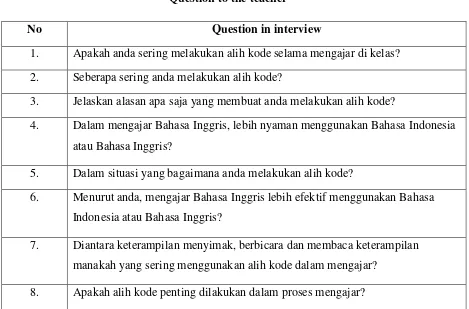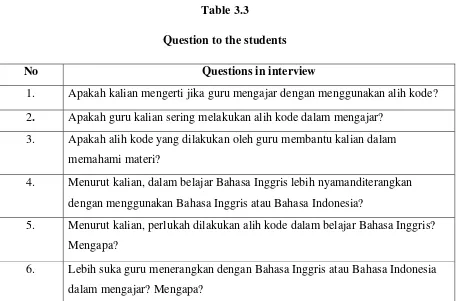CHAPTER III
RESEARCH METHODOLOGY
This chapter presents and discusses the method of research in details. It covers
research questions, research method, data collection and data analysis.
3.1 Research Questions
There are three questions to be investigated in this study. The questions are formulated
as follows:
1. What types of code switching are found in the EFL classroom?
2. Why do the teacher switch codes in the EFL classroom?
3. What are the students’ perceptions toward teacher’s switching in the EFL
classroom?
3.2 Research Designs
This study utilizes a qualitative method with descriptive research in
particular.Qualitative method is chosen because it allows the researcher to capture naturally
people’s personal perspective, interaction and experience (Freankle & Wallen, 2011, p. 435). In this case, the researcher tends to explore the phenomenon teacher’s switching
naturally in the classroom. Particularly analyze the types, reasons and the students’
perception toward teacher’s switching in an EFL classroom. According to Freankle & Wallen (2011 p. 425) qualitative method is appropriate for research in education and it
Furthermore, this study is a qualitative case study. (Merriam as cited in Duff, 2009)
defines case study as “The process of actually carrying out the investigation, the unit of
analysis the bounded system, the case or the end product”. Then, Creswell (2012) argued
that case study is an exploration of “bounden system” or case or multiple cases over time
through detailed in depth data collection involving multiple sources of information rich in
context. Since this study explore the phenomenon of code switching in single subjects, thus
case study is suitable for this research.
3.3 Site and Participants
The research was conducted in one of Junior High Schools in Bandung. The
researcher considers some aspects in choosing the school, which includes the school is
accredited as grade A and it is relatively accessible, both administratively and distances.
The respondent of this study were a teacher and 35 students of eighth graders who
are Indonesian native speaker. The teacher was chosen for the reasons that the he has been
teaching at all levels from seventh grade to ninth grade and he has been teaching for more
than five years that is why he has long experience in teaching English.
3.4 Data Collection
In collecting the data, the researcher utilizes three forms, which include classroom
observation, interview and questionnaire. In addition, through three forms of data collecting
techniques the researcher identify the types of code switching found in an EFL classroom,
find out the reasons of the teacher for using code switching and analyze students’
3.4.1Classroom Observation
According to Alwasilah (2008, p.98) observation is a systematic process of
monitoring and detailed examination of participants’ behavior in naturalistic setting. The
observation was conducted inan eighth grade class. Since the study identified the types of
code switching in an EFL classroom, therefore classroom observation was suitable
technique of collecting the data. The types of observation utilized non-participant
observation. Fraenkle and Wallen (2011, p. 441) states that non participants belong tothe
situation when the researcher is presented at the scene of action and only observed the
condition during the teaching and learning process in the classroom without interact or
participate. Therefore, the researcher was not directly involved in the activity of teaching
and learning process. The table below explains the schedule of observation and its content:
Table 3.1
Table of the schedule ofclassroom observation
Date Activity
May 25th, 2015 Recording classroom activity
May 28th, 2015 Recording classroom activity
June 2nd, 2015 Recording classroom activity
In order to gain more useful data for this study, classroom observation was
conducted three times in two weeks. In the first meeting, the teacher taught listening and
speaking skill. In the second meeting, he taught reading and writing skill and in the third
meeting he taught writing skill.The activities during the observation were documented as
in an EFL classroom based on the theory proposed by Poplack. In addition, according to
Alwasilah (2002) transcription is useful for the researcher in order to understand how
respondent organized their perspective.
3.4.2 Interview
The second technique of collecting the data of this study was interview. According
to Freankle and Wallen (2011, p. 445) interview is an important way for the researcher in
order to gain information from the respondent.The interview was conducted after doing the
observation. Semi-structured interview was used to gain the information from the teacher
and students. Crocker (2010, p.186) argues that semi structured interview covered all the
intended topic and the respondent feel that they are taking a part in a conversation with a
purpose.Freankle and Wallen (2011, p. 446) further highlight that semi structured interview
is designed to elicit a specific information from the respondent. The interview consisted of
several questions related to the use of code switching in an EFL classroom and students’
perception toward teacher’s switching in EFL classroom.
To get more detailed information, the researcher interviewed one teacher and
sixstudents. Studentswho involved in the interview were chosen based on their English
score in their class. They were student who got the highest score, students who gota middle
score and student who gotthe lowest score.The researcher assumed that six students
represent all members in the class.
To avoid misunderstanding and to make the interview easier for the participants to
answer the questions, the questions in the interview were delivered in Bahasa Indonesia. It
was recorded using a voice recorder. Then, the recording was transcribed, coded and
The questions for interviews can be seen in the following tables.
Table 3.2
Question to the teacher
No Question in interview
1. Apakah anda sering melakukan alih kode selama mengajar di kelas?
2. Seberapa sering anda melakukan alih kode?
3. Jelaskan alasan apa saja yang membuat anda melakukan alih kode?
4. Dalam mengajar Bahasa Inggris, lebih nyaman menggunakan Bahasa Indonesia
atau Bahasa Inggris?
5. Dalam situasi yang bagaimana anda melakukan alih kode?
6. Menurut anda, mengajar Bahasa Inggris lebih efektif menggunakan Bahasa
Indonesia atau Bahasa Inggris?
7. Diantara keterampilan menyimak, berbicara dan membaca keterampilan
manakah yang sering menggunakan alih kode dalam mengajar?
8. Apakah alih kode penting dilakukan dalam proses mengajar?
Some of the questions above are adopted from the study of code switching
conducted by many researchers. Question 1 & 2 relate to the statement of Sert (2006)
“code-switching has come into use in language teaching classes, either within the teachers’
or the students’ discourses”. Then, question 3is based on the study conducted by Chowdhury (2013). He mentioned some reasons for classroom code switching such as class
statement of Cook (2001) “Using L1 in English classrooms gives the students an opportunity to understand well”. Furthermore, Question 6 is relevant with the statement of
some experts who argued that “Code switching to mother tongue while teaching target
language may be productive or even necessary at some times” (Atkinson, Auerbach,
Canagarajah, Frankenberg-Garcia, Harmer, Murakami as cited in Magid& Mugaddam
2013). Moreover, question 8 relates to the theory of Brown (2001) and Harmer (2007) who
argued that the use of L1 in EFL classroom will give benefit for the students because it
gives them some access what is being learnt with their own prior knowledge and
experiences.
Table 3.3
Question to the students
No Questions in interview
1. Apakah kalian mengerti jika guru mengajar dengan menggunakan alih kode?
2. Apakah guru kalian sering melakukan alih kode dalam mengajar?
3. Apakah alih kode yang dilakukan oleh guru membantu kalian dalam
memahami materi?
4. Menurut kalian, dalam belajar Bahasa Inggris lebih nyamanditerangkan
dengan menggunakan Bahasa Inggris atau Bahasa Indonesia?
5. Menurut kalian, perlukah dilakukan alih kode dalam belajar Bahasa Inggris?
Mengapa?
6. Lebih suka guru menerangkan dengan Bahasa Inggris atau Bahasa Indonesia
Some questions to the students are based on the study conducted by some experts in
the field of code witching. Question 2 is closely related to the statement of Cook (2001)
“Classroom activity is natural code switching situation”. In addition, questions 3 & 4are relevant to the statement of Butzkamm, Castellotti & Moore, McMillan & Rivers(as cited
in Bailey, 2011) who point out that the pedagogical purposes of codes-switching such as;
facilitating student comprehension, helping students’vocabulary and managing classroom
activities.Question 5 is based on the statement of Greggio& Gil (as cited inBensen, 2013)
“code switching has an important role in teaching and learning process in the classroom”.
3.4.3 Questionnaire
A questionnaire was used as an instrument in order to analyze the students’
perception toward teacher’s switching in an English as a foreign language classroom. The
questionnaire was distributed to the students and consisted of 11 closed ended questions
which were set based on some aspects. According to Freankle and Wallen (1993, p. 351)
the advantages of using closed ended are that they can enhance consistency of the
respondent, tabulate the result faster and easier and be more familiar with respondents.
There are several aspects related to the students’ perceptions toward teacher’s switching; these include students’ interest in English, students’ preferences, students’
ability in learning English, students’ difficulty in learning English and students’ needs.
3.5 Data Analysis Technique
In doing classroom observation the researcher documented the activityused video
recorder. The video was transcribed, coded and analyzed the types of code switching found
transcription, the researcher highlightedthe word, phrase or clause which considered as
code switching.
During the interview, the researcher documented the activity used voice recorder.
The recording was converted into transcription. The transcript of the interview was coded
and analyzed to see the reason of the teacher for using code switching in an EFL classroom
and to support the result from questionnaire related tostudents’ perception toward teachers’
switching in an EFL classroom.
The result of the questionnaires presented in the graphic. The data were identified to
answer the questions ofstudents’ perception toward teacher’s switching in an EFL


